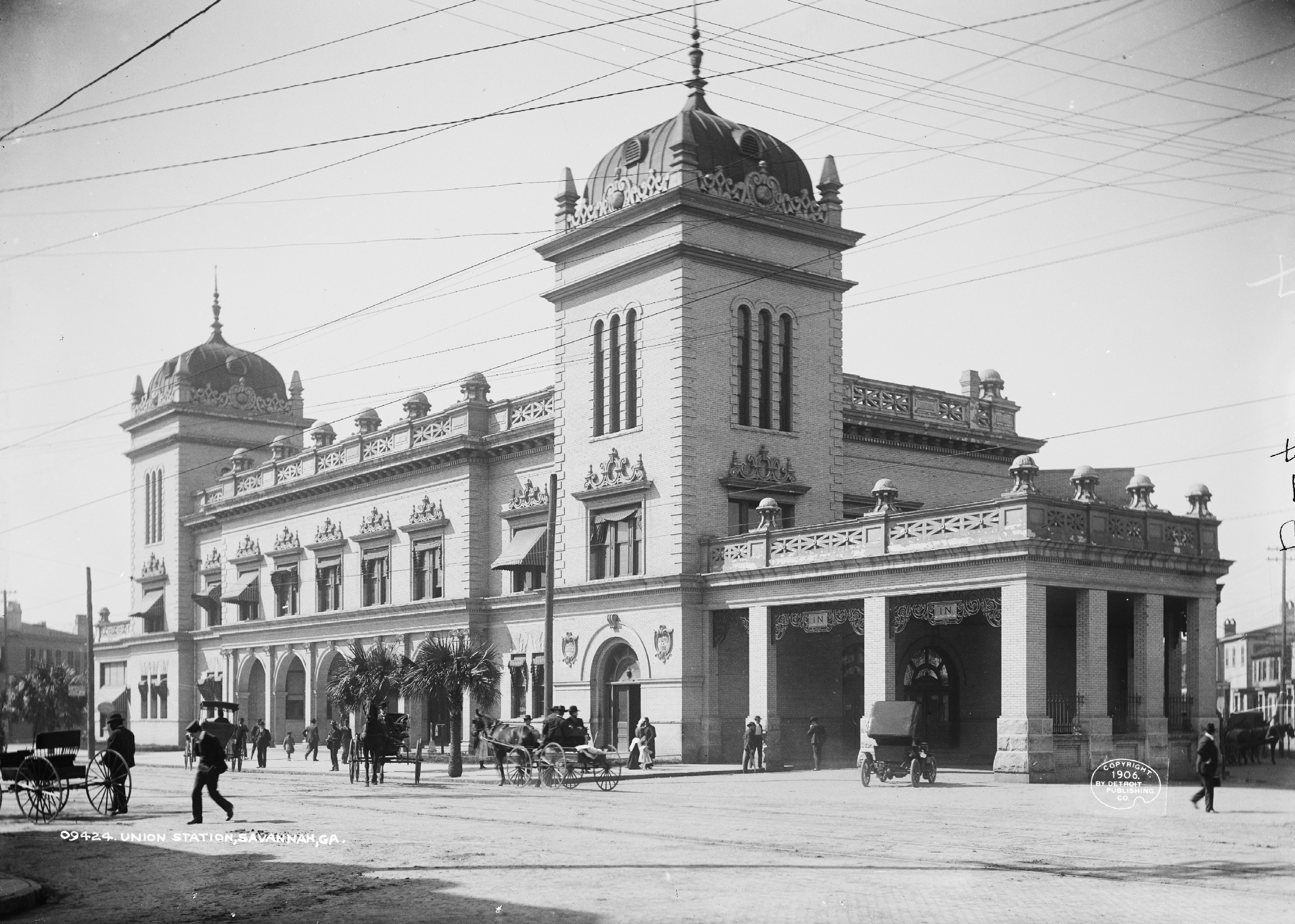Savannah Union Station: The City's Elegant Terminal
Published: January 31, 2025
By: Adam Burns
Savannah Union Station once stood as a symbol of architectural grandeur and transportation innovation in the heart of Savannah, Georgia.
This significant landmark witnessed the ebb and flow of travelers as well as the technological and social transformations of the late 19th and early 20th centuries.
To truly appreciate the story of Savannah Union Station, we must delve deep into its history, examining both the impact it had during its operation and the legacy it left behind.
 Savannah Union Station, circa 1906. Detroit Publishing Company glass-plate negative/Library of Congress collection.
Savannah Union Station, circa 1906. Detroit Publishing Company glass-plate negative/Library of Congress collection.Early Transportation in Savannah
Savannah has always been a significant center for commerce and transportation due to its strategic location along the Georgia coast.
In the early 19th century, Savannah emerged as a key port in the Southern United States, driving the need for more advanced transportation infrastructure.
Prior to the establishment of Union Station, multiple rail lines ran through Savannah - notably the Atlantic Coast Line, Seaboard Air Line, and Southern Railway - connecting it to various parts of the Southeast and facilitating the movement of both goods and people.
The Need for a Union Station
By the latter half of the 19th century, railroads had become the primary mode of long-distance transportation in the United States.
As Savannah's industries and population grew, the city became a crossroads for several major rail routes. This growth, however, resulted in the chaotic overlap of several competing rail companies, each with their own stations scattered throughout the city.
The old stations were often ill-equipped to handle the increased volume of passengers and freight, leading to inefficiencies and overcrowding. Union Stations were a solution implemented nationwide to address such issues, centralizing services in a single, more efficient location.
The concept allowed travelers to connect between different lines with greater ease and streamlined operations for the rail companies, which jointly owned and operated the facility. Thus, the proposal for a Union Station in Savannah was set into motion.
Construction and Design
In the late 1890s, discussions to unify Savannah's rail services into a singular, grand terminal began to solidify. The Savannah Union Station was constructed through a cooperative effort among the aformentioned Seaboard Air Line, Southern, and Atlantic Coast Line.
Interestingly, while the Central of Georgia Railway and Savannah & Atlanta Railroad (a future Southern subsidiary) also served Savannah both used a different facility within the city.
Architect Frank Pierce Milburn of Columbia, South Carolina was commissioned to design the station. He created a masterpiece in the Spanish Renaissance and Elizabethian styles.
The centerpiece of the design was an octagonal rotunda with a diameter of 80 feet, functioning as the main waiting area. Throughout much of the station's history, it operated within the confines of the South's Jim Crow segregation laws, necessitating a separate waiting area designated for African-Americans.
The structure's exterior was constructed with pressed brick and featured embellishments of granite and terra cotta. Additionally, the building was distinguished by the presence of two towers.
Operational Years and Significance
Completed at a cost of $150,000, Savannah Union Station officially opened its doors in 1902, marking a new chapter in Savannah's transportation history. As a central node for both passenger and freight trains, the station quickly became a bustling hub of activity.
As rail travel was a primary form of intercity transportation during the early to mid-20th century, Union Station helped place Savannah on the map as a prominent Southern city.
During the streamlined era many notable trains made stops at Union Station including ACL's Champion, Everglades, Havana Special (Florida East Coast), and Palmetto; SCL's Palmland, Silver Meteor, Sunland, and Tidewater; and Southern's Skyland Special.
Decline and Demolition
The mid-20th century saw a decline in passenger rail travel, driven by the increasing popularity of automobiles and the rapid growth of airline travel. By the 1950s, the bustling activity that had characterized Union Station began to wind down. The once-grand halls echoed with the footsteps of fewer and fewer travelers as the dominance of rail transportation waned.
In August, 1962, Savannah Union Station closed its doors when remaining trains moved to a new ACL facility on the outskirts of town and still in use today by Amtrak.
Unfortunately, at a time when historic preservation was not as valued as it is today, the station was demolished in 1963 to make way for the construction of the Interstate 16 connector (Earl T. Shinhoster Interchange), part of the nation's expanding highway system. This decision was met with some local opposition, but progress and modern convenience took precedence over preservation.
Legacy
While Savannah Union Station no longer stands, its legacy endures in several ways. The station was an architectural marvel that demonstrated early 20th-century design and engineering prowess. It was a testament to the power of cooperation among competing railway companies, setting a precedent for future developments in transportation infrastructure across the United States.
Union Station’s historical role in Savannah's development and its impact during pivotal moments in American history ensure that it remains a cherished memory in the city’s narrative. Efforts to remember the station are evident in various historical societies and preservation groups that highlight Savannah’s rich transportation history.
Recent Articles
-
New Mexico Railroad Museums: A Complete Guide
Apr 23, 25 02:25 PM
The enchanting state of New Mexico, known for its vivid landscapes and rich cultural heritage, is home to a number of fascinating railroad museums. -
New Hampshire Railroad Museums: A Complete Guide
Apr 23, 25 02:11 PM
New Hampshire, known for its breathtaking landscapes, historic towns, and vibrant culture, also boasts a rich railroad history that has been meticulously preserved and celebrated across various museum… -
Minnesota Railroad Museums: A Complete Guide
Apr 22, 25 12:17 PM
The state of Minnesota has always played an important role with the railroad industry, from major cities to agriculture. Today, several museums can be found throughout the state.